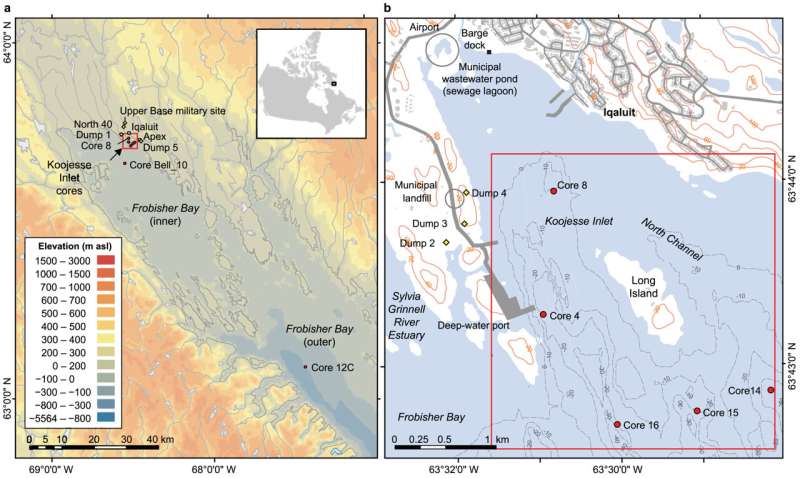This article has been reviewed according to Science X's editorial process and policies. Editors have highlighted the following attributes while ensuring the content's credibility:
fact-checked
proofread
Sedimentary records of contaminant inputs in Frobisher Bay provide record of changes in contaminant levels over decades

Although contaminant levels in Arctic environments are often lower than those in temperate locations close to cities and industrial areas, contaminant studies in the Arctic remain important due to the potential for bioaccumulation and biomagnification through food webs to top consumers and humans. Regions important for traditional food harvesting are a priority for monitoring.
Contaminants primarily reach the Arctic through long-range atmospheric and oceanic transport, but local sources within the Arctic, including legacy sources and new sources associated with commercial and industrial development, also contribute to the levels observed in the environment.
A major population center in the Canadian Arctic that has seen increased human activity during recent decades is the City of Iqaluit, the capital of the Canadian territory of Nunavut. Iqaluit is located at the head of Frobisher Bay, an area where Inuit continue to harvest country food.
Research led by Meaghan C. Bartley of the Center for Earth Observation Science (CEOS) at the University of Manitoba, and published in Environmental Science and Ecotechnology, found evidence of impacts from both local source and long-range transport in the marine sediment of Frobisher Bay, Nunavut, via seven dated sediment cores collected from sites near Koojesse Inlet (close to Iqaluit), and inner and outer Frobisher Bay.
Contaminants detected included total mercury (THg), major and trace elements, polycyclic aromatic hydrocarbons (PAHs), polychlorinated biphenyls (PCBs), and per- and polyfluoroalkyl substances (PFASs). These findings show that pollution effects leave a long legacy in the environment and include both local and long-range effects.
Sediments collected 1.8 km away from Iqaluit, in the Koojesse Inlet, received inputs of THg, PAHs, PCBs, and PFASs primarily originating from activities in and around Iqaluit.
Records of THg in sediment suggest that although concentrations were not different from other areas of the Arctic, inputs were connected to local civilian and military activities (e.g., thermometers, fluorescent light bulbs, electrical switches), and were potentially moved from the terrestrial to coastal environment by local activities such as construction.
A peak in PCB concentrations was concurrent with military site presence from the 1950–60s, and congener composition in the sediment resembled that of the industrial PCB mixture Aroclor 1260. PCB contamination associated with the historic civilian and military activity in Iqaluit continues to represent a source of PCBs to coastal sediments, albeit reduced from a factor of at least 4-times from its peak in the ∼1960s.
PAH concentrations increased in recent sediments and exhibited a pyrogenic signature, likely reflecting increased fossil fuel burning for transportation (ships and airplanes), heating and electricity associated with the rapid population growth of Iqaluit in recent decades, northern development, and waste burning.
The dominant PFASs observed close to Iqaluit were associated with airport and military activities. This core exhibited a peak in PFOS and PFDS, which may be explained by legacy aqueous film-forming foam (AFFF) usage. Fluorotelomer carboxylic acids (FTCAs) increased closer to the surface, which could be from the phase out of PFOS formulations of AFFF towards fluorotelomer chemistry.
This study provides evidence for the importance of both long-range contaminant sources and local inputs in Arctic environments. These results highlight that even after the clean-up of legacy military sites, there remains an impact on the environment for many decades.
As human activities escalate in the Arctic, comprehensive investigations into contaminant levels and prospective ecological ramifications hold paramount importance for evaluating risks within regions of significance for traditional food harvesting.
More information: Meaghan C. Bartley et al, Sedimentary records of contaminant inputs in Frobisher Bay, Nunavut, Environmental Science and Ecotechnology (2023). DOI: 10.1016/j.ese.2023.100313
Provided by Eurasia Academic Publishing Group




















